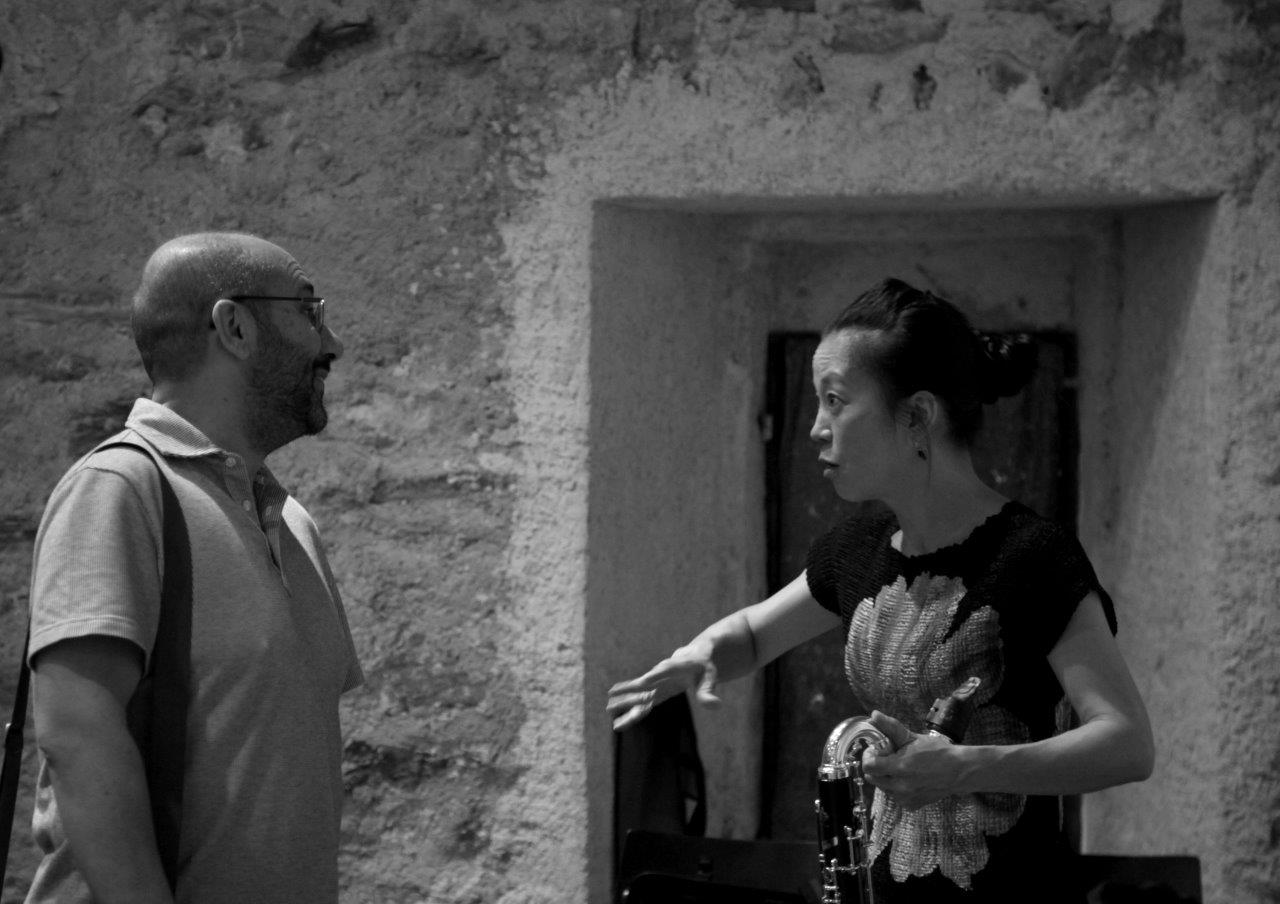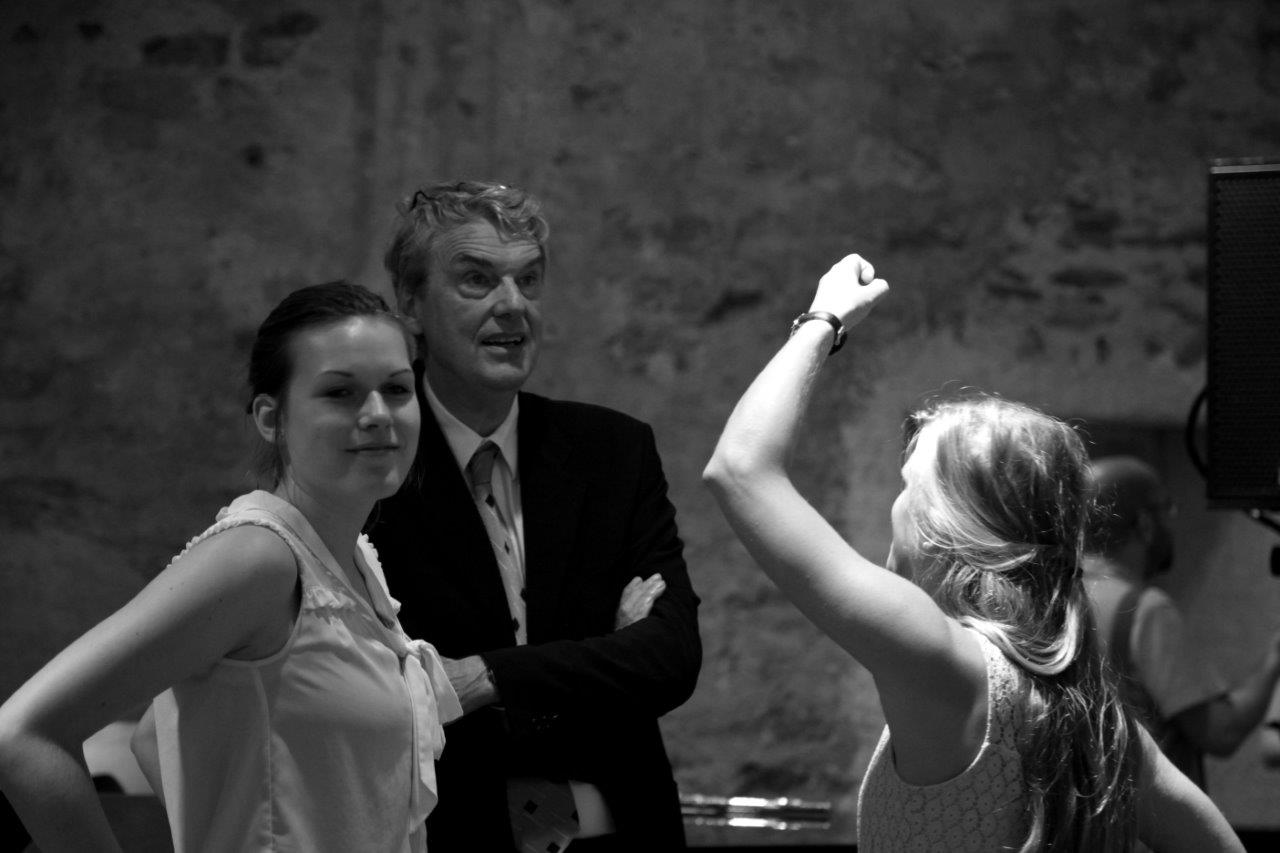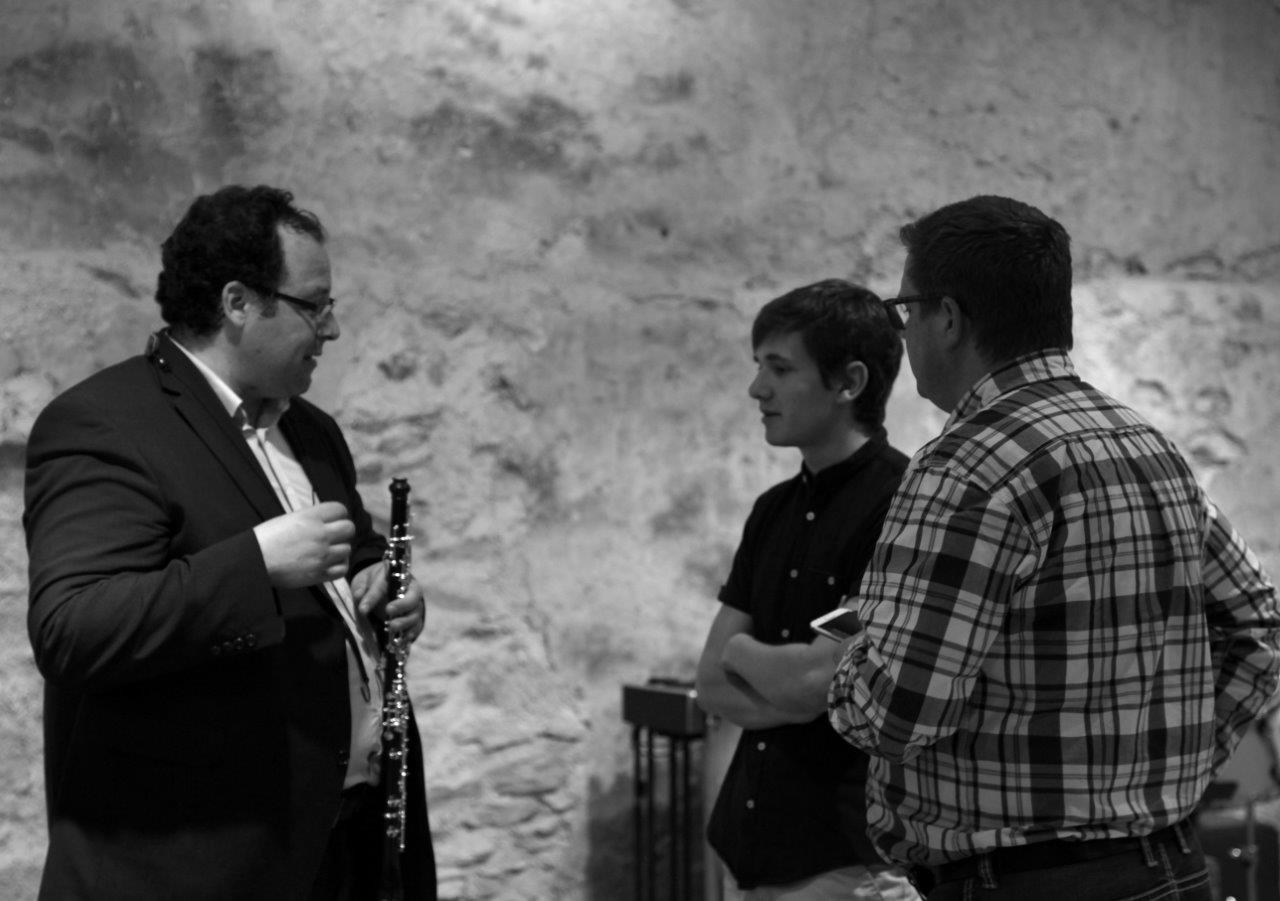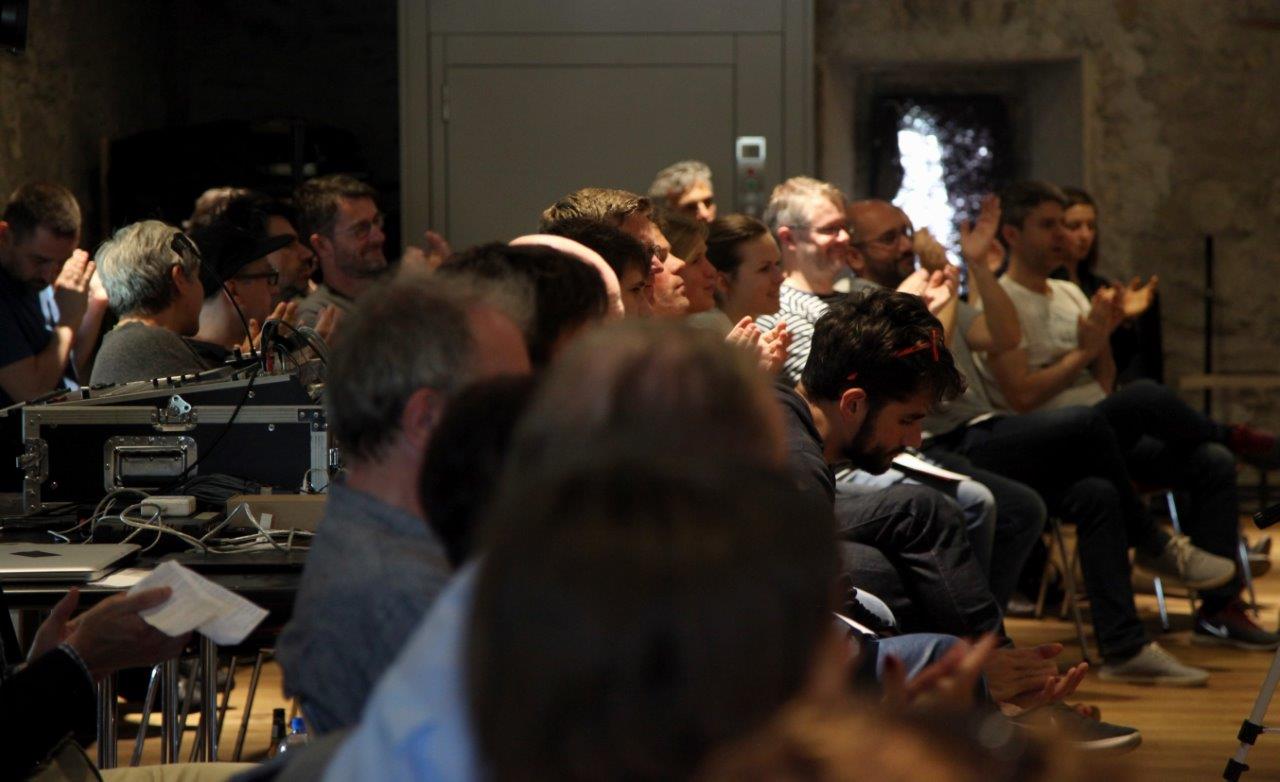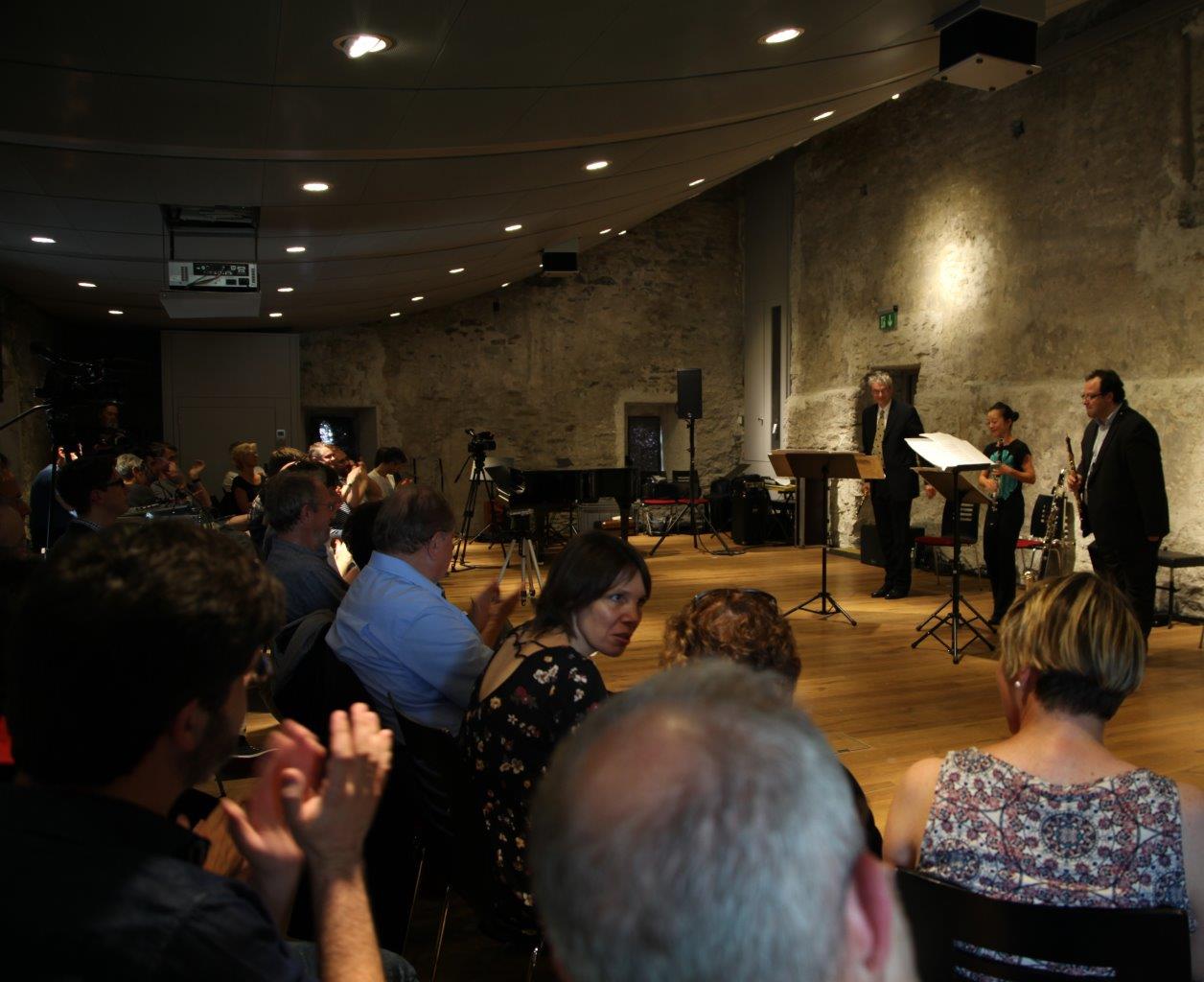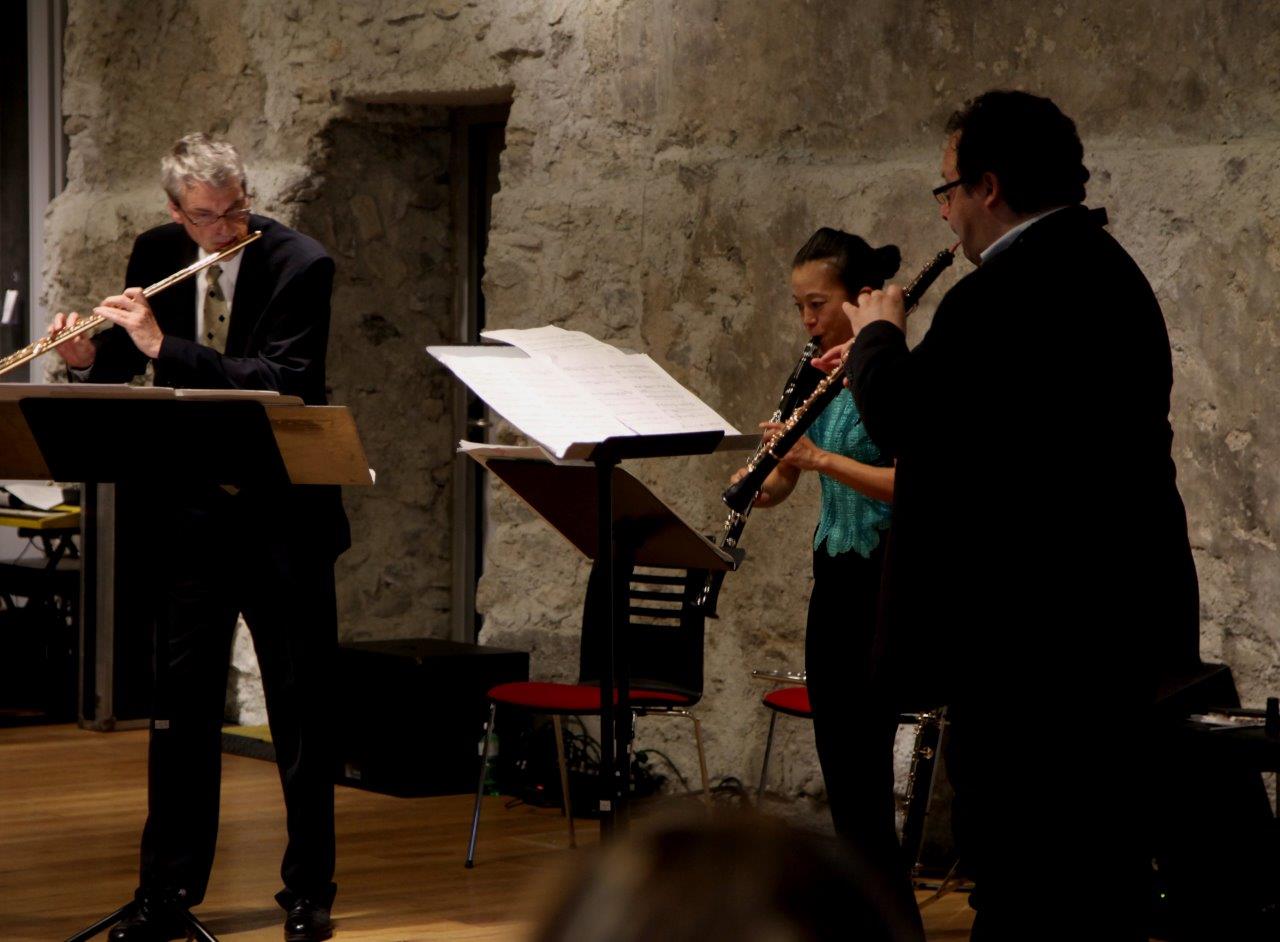|
SONNTAG -
4 JUNI 2017 - 18h - Schloss Leuk
ENSEMBLE RECHERCHE (Freiburg i. Br.)
ENSEMBLE RECHERCHE ensemble recherche Das ensemble recherche macht Musikgeschichte. Mit rund 600 Uraufführungen seit der Gründung 1985 hat das Ensemble die Entwicklung der zeitgenössischen Kammer- und Ensemblemusik entscheidend mitgestaltet. Impulse werden gesetzt mit Konzerten, Musiktheater, Kursen für Komponisten und Instrumentalisten, Produktionen zum Hören und Sehen, mit Kinder- und Jugendklangprojekten, der "Klangpost" und der gemeinsam mit dem Freiburger Barockorchester veranstalteten Ensemble-Akademie Freiburg. Das neunköpfige Solistenensemble bestimmt mit seiner eigenen dramaturgischen Linie das internationale Musikleben mit. Im Repertoire sind Klassiker des ausgehenden 19. Jahrhunderts, Impressionisten wie Expressionisten, Komponisten der Zweiten Wiener und der Darmstädter Schule, Spektralisten und experimentierfreudige Avantgardisten der Gegenwartskunst. Rund 50 CDs hat das ensemble recherche veröffentlicht, sie wurden mehrfach ausgezeichnet mit internationalen Preisen, u.a. dem Jahrespreis der Dt. Schallplattenkritik und dem Diapason d`Or. Das ensemble recherche wird vom Ministerium für Wissenschaft, Forschung und Kunst Baden-Württemberg und vom Kulturamt der Stadt Freiburg institutionell gefördert.
PROGRAMM Walter Zimmermann (*1949) Nicolas von Ritter (*1986) Christian Mason (*1984) György Kurtág Marc Garcia Vitoria (*1985) Salvatore Sciarrino
Walter Zimmermann (* 15. April 1949 in Schwabach) ist ein deutscher Komponist, Autor und Hochschullehrer. Frühzeitig lernte Zimmermann Klavier, Violine und Oboe. Bereits mit zwölf Jahren begann er zu komponieren, besuchte das Humanistische Gymnasium in Fürth und studierte Klavier bei Ernst Gröschel. Von 1968 bis 1970 war er Pianist im ars-nova-ensemble in Nürnberg und begann ein Kompositionsstudium bei Werner Heider. 1970 wechselte er an das Institut für Sonologie in Utrecht und war auch bis 1973 am ethnologischen Zentrum Jaap-Kunst in Amsterdam tätig. 1974 begab er sich nach Amerika, wo er in Hamilton Computermusik studierte. Hier erschien 1976 auch sein erstes Buch Desert Plants, dem sich Aufnahmen von Volksmusik in der Oase Siwa, in einem Ghetto in Pittsburgh, und in einem Indianerreservat in Montana anschlossen. Nach Deutschland zurückgekehrt, veranstaltete er Konzerte im Beginner Studio, einer ehemaligen Fabrikhalle in Köln. Für seine Arbeiten erhielt er unter anderem 1980 das Bernd-Alois-Zimmermann-Stipendium der Stadt Köln und 1981 den ersten Preis Ensemblia Mönchengladbach. Nachdem er 1981 sein zweites Buch Insel Musik veröffentlicht hatte, war er 1982 und 1984 als Dozent in Darmstadt tätig und war nebenher von 1980 bis 1984 als Kompositionslehrer am Conservatoire de Liège aktiv. Als 1985 sein drittes Buch Morton Feldman Essays erschienen war, zog er über Berlin nach Rom. Hier erhielt er 1988 den Prix Italia für das Werk Die Blinden und nahm im gleichen Jahr einen Lehrauftrag in Den Haag am Koninglijk Conservatorium an. Zugleich war er in Frankfurt tätig und erhielt 1989 den Schneider-Schott-Musikpreis Mainz. Von 1990 bis 1992 arbeitete er als Kompositionslehrer in Karlsruhe und organisierte in dieser Zeit in Frankfurt gemeinsam mit Stefan Schädler das Festival Anarchic Harmony, zum 80. Geburtstag von John Cage. Seit 1993 ist er Professor für Komposition an der Hochschule der Künste Berlin, seit 1996 zudem Dozent der June in Buffalo (USA) und 2003 Gastprofessor (ein Studienjahr) an der ESMUC (Musikhochschule) Barcelona. 2005 trat er zudem die Stelle eines Lecturer Julliard School an der Columbia University in New York an. Auch ist er Dozent der Universidad de Alcalà de Henares in Spanien, 2006 Lecturer am Shanghaier Conservatory und am Beijing Central Conservatory sowie seit 2006 Mitglied der Akademie der Künste. 2007 wurde er Composer in Residence am New England Conservatory of Music in Boston. 2009 Ernennung zum Ehrenprofessor des Central Conservatory of Music in Beijing. https://de.m.wikipedia.org/wiki/Walter_Zimmermann_%28Komponist%29 Shadows of Cold Mountain 3 für Flöte, Oboe, Klarinette (1997). Das Stück übersetzt die gestisch-kalligraphischen Liniengeflechte von Brice Marden in KIang. Was dort freiheitlicher Ausdruck einer losen, weiten und schweifenden Linienfolge ist, wird hier zum Grenzgang. Flöte, Oboe und Klarinette sind nicht für Grenzenloses gebaut, jede Freiheit kommt in Konflikt mit der Mechanik. Die schweifende Linie wird strengstes Abmühen. So weit können Malerei und Musik auseinander liegen. Jedoch trifft sich Farbwelt und Tonweit, jenseits dieser Anstrengung, in Mannigfaltigkeit der Verbindungen der sekundären Klangprozesse der Interferenztöne und Differenztöne. Die primäre Gestik des Malens wird hier erst in der sekundären Klangebene wahrnehmbar.
Bird fight. Drei kleine, lärmende Vögel in einem epischen Flug, das ist es, wovon das Stück handelt. Es startet mit einer friedlichen Wanderung, die von einem abscheulichen Biss unterbrochen wird: ein vergiftender Schock für unsere Vögel, deren Geist nun mit Verfolgungswahn infiziert ist ... Im Gleitflug, einander anstarrend, auf den richtigen Moment zum Sturzflug wartend ... Wackelnd und trudelnd in nur kurz dauernden, aber heftigen Nahkampf-Situationen. Und erneut versteckt in hohen Wolken, den nächsten bösartigen Angriff vorbereitend. -- Ähnlich einem Boxkampf, in dem die interessantesten Dinge genau dann passieren, wenn die Gegner müde werden. Die Flugbahnen werden unsicher und die Reaktionen unberechenbar ... So sehr unvorhersehbar, dass wir in diesem Kampf keinen Sieger erkennen können ... Nicolas von Ritter (Übersetzung: Sabine Franz)
Christian Mason (b.1984) defines composition as “searching in sound for fleeting solidifications of intangible experiences”; his music, which combines an emotional aspiration to radiance with a sensitivity to natural resonance, has been commissioned, performed and broadcast internationally. 2015 saw the premieres of Open to Infinity: a Grain of Sand, co-commissioned for Pierre Boulez’s 90th birthday by Lucerne Festival and the BBC PROMS, Layers of Love recorded by Klangforum Wien and premiered in Japan by Tokyo Sinfonietta, and Sympathetic Resonance, recorded by the Orchestre National de France for broadcast on Radio France’s ‘Alla Breve’ programme. Current commissions include Lahara, a percussion sextet for the opening season of the Asian Arts Theatre in Gwangju, South Korea; Sonorous Islands for ensemble with audience participation co-produced by the London Sinfonietta, Ensemble Modern, Asko/Schönberg and Remix Ensemble as part of the ‘Connect Project’; a piece for the Münich Chamber Orchestra, a programme written for the ‘Music of Today’ series with the Philharmonia Orchestra and an opera organised by the Royal Opera House. Christian was previously a Resident-Composer at the Lucerne Festival Academy where his orchestral work Isolarion: Rituals of Resonance was premiered in 2013. The same year, The Years of Light was given its premiere as part of the Tanglewood Contemporary Music Festival, USA. In 2014 Unseen Seasons was commissioned by the Shizuoka Concert Hall for the Tokyo Philharmonic Chorus, while his first operatic work Reunion, part of Opera Erratica’s production Triptych was performed in London. His piece Learning Self-Modulation, for violin and piano, was performed in Paris, Fribourg, London, Amsterdam and Madrid, by Carolin Widmann and Simon Lepper, subsequently receiving a British Composer Award in 2012. Previous works have been performed by Midori, Jean-Guihen Queyras, the London Symphony and the BBC Philharmonic Orchestras, to name a few. A Composer in Residence at Eton College in 2014/15, Christian previously worked as Composition Assistant to Sir Harrison Birtwistle, and continues to teach on the LSO Panufnik Young Composers Project. He read Music at the University of York before pursuing a Ph.D at King’s College London with George Benjamin, 2008 – 12, following which he was awarded the 2012 Mendelssohn Scholarship. Christian is the founding co- Artistic Director of the Octandre Ensemble. His works are now published by Breitkopf & Hartel. http://www.christianmason.net/biography/ In Space Enlaced. Christian Mason erhielt im Vorjahr den Förderpreis der Ernst von Siemens-Musikstiftung. Aus diesem Anlass gab die Stiftung ein Porträt bei Paul Griffith, dem großen alten (und gestrengen) Mann der englisch-sprachigen Musikkritik, in Auftrag. Darin heißt es, Mason traue sich, „sich auf Gefühle einzulassen – wenngleich niemals in der Musiksprache, der von Dur und Moll, über die sie in der Vergangenheit vermittelt wurden. Die leuchtenden Klangresonanzen in Masons Musik haben sich vom Dreiklang frei gemacht. Das Ergebnis ist Ausdruck einer besonderen Kraft, die Gefühle in reine Zustände wandelt, in freudige Melancholie oder melancholische Freude, oder in Exstase, Verwunderung und Überschwang, die allesamt zu den Lichtklängen gehören. Ihre Stärke erzielt die Musik nicht nur, weil sie in ihrer Unmittelbarkeit ihren Weg ohne den Dreiklang findet, sondern weil sie als Ritual verstanden werden will. Dies ist weit weniger eine Sache der Form als der Einstellung. Mason fügt seine Musik nicht aus getrennten Blöcken, nach Art Messiaens; auch wenn er die Werke in Sätze einteilt, behalten sie einen durchgängigen Puls. Dieser Puls zieht uns als Hörer durchaus in seinen Bann, und doch scheint er einem Bereich jenseits der menschlichen Ordnung anzugehören.“ Die ineinander übergehenden Abschnitte des Trios
für Holzbläser sind überschrieben mit: Der Komponist selbst gibt einen kurzen technischen Hinweis und nennt seine Inspirationsquelle: „Dieses Stück ist eine Re-Komposition und Ausweitung meines früher geschriebenen ‚Trio: In Time Entwined’ für Bassflöte, Englischhorn und Bratsche. Im Laufe von ‚In Space Enlaced’ sind die drei Instrumente in verschiedenen kontrapunktischen und heterophonen Verflechtungen miteinander verbunden. Die individuellen Identitäten fügen sich zu einem kollektiven Dasein zusammen. Als Inspiration diente mir der surreale Ausdruck von Liebe in David Gascoynes Gedicht ‚Antennae’.“ The timeless sleepers tangled in the bed Text by Sabine Franz/ensemble recherche
Marc Garcia Vitoria. Born in 1985 in Valencia (Spain), he studied composition at the ESMUC in Barcelona with Luis Naón, Ramón Lazkano and Gabriel Brncic, and obtained a MA in Music Composition and Theory at the Haute École de Musique of Geneva with Michael Jarrell, Luis Naón and Eric Daubresse, specializing in Electroacoustic and Instrumental Composition. He developed the technical part of his MA project at the IRCAM, in Paris, by following the Cursus 1 and 2 under Yan Maresz’s guidance, for which he received the financial help of “la Caixa” Foundation. Ensembles like Contrechamps, Linea, Intercontemporain or Recherche have performed his pieces. He has attended workshops and seminars like Villafranca del Bierzo 2006 or Royaumont 2010, and masterclasses by T. Murail, B. Ferneyhough, L. Lim, M. Stroppa, F. Filidei, H. Kyburz… In 2008 he was finalist of the “Reine Marie José Composition Prize", in 2011 he was awarded the “University of Aberdeen Music Prize”, for which he received a commission for the BBC Scottish Symphony Orchestra, and in 2013 he received the Young Composers Prize from foundation SGAE-CNDM. He has also received commissions from “Insititut Valencià de la Música”, “Radio France” or the French Ministry for Culture. He was engaged as resident composer by “La porta clàssica” for the concerts season “Joves Intèrprets Catalans IV 2007/2008” and for the “Transform/Write Down” program of the Abbaye de Royaumont 2011/12. He worked as Assistant Professor at the Haute École de Musique of Geneva between 2011 and 2014. He is currently working as composition teacher at the Conservatorio Superior de Música Oscar Esplá de Alicante. http://www.garcia-vitoria.com/index.php/about/eng/ * 1985 in Valencia, ausgebildet in Barcelona, Paris und Genf. Schreibt vom Solostück bis zum großen Orchester, häufig unter Nutzung neuer Technologien zur Klangerweiterung. Erste Aufträge vom BBC Scottish Symphony Orchestra und dem Ensemble Intercontemporain. Lebt zur Zeit in Genf. Nächstes Stück: ein Concerto Grosso in Zusammenarbeit u.a. mit dem IRCAM, Aufführungen werden im Genfer Festival Archipel und in Paris sein. „Mans enceses“ steht in der Literatur für brennende Hände, auch erleuchtete Hände. Dieses poetische Bild habe ich einem Gedicht von Vicent A. Estellés entnommen, der einen ländlichen Tanz eines jungen Paares beschreibt, das seine Liebe und Leidenschaft zueinander fühlt, aber nicht offen ausdrücken kann, sie sind ‚beschränkt’ auf den Tanz. Interessanterweise schrieb Estellés sein Gedicht so, dass der Text rhythmisch dem Ablauf eines Bolero entspricht, jenem spanischen Tanz, der durch einen bestimmten französischen Komponisten berühmt wurde ... Ich habe eine Reflexion dieses Bildes des wetteifernden Tanzes versucht, mit der Beibehaltung der Bewegung und abwechselnd dazu dem Einsatz von mehr ‚tänzerischen’ Momenten. Auf seine Weise ist das Stück auch ein Tanz, betrachtet man das Zusammenspiel der Musiker, die immer wieder dieselben Noten, Motive und Rhythmen spielen ... und dabei den anderen beobachten. Marc Garcia Vitoria (Übersetzung: Sabine Franz)
Salvatore Sciarrino (Palermo, 1947) boasts of being born free and not in a music school. He started composing when he was twelve as a self-taught person and held his first public concert in 1962. But Sciarrino considers all the works before 1966 as an developing apprenticeship because that is when his personal style began to reveal itself. There is something really particular that characterizes this music: it leads to a different way of listening, a global emotional realization, of reality as well as of one’s self. And after forty years, the extensive catalogue of Sciarrino’s compositions is still in a phase of surprising creative development. After his classical studies and a few years of university in his home city, the Sicilian composer moved to Rome in 1969 and in 1977 to Milan. Since 1983, he has lived in Città di Castello, in Umbria. He has composed for: Teatro alla Scala, RAI, Teatro del Maggio Musicale Fiorentino, Biennale di Venezia, Teatro La Fenice di Venezia, Teatro Carlo Felice di Genova, Fondazione Arena di Verona, Stuttgart Opera Theatre, Brussels La Monnaie, Frankfurt Opera Theatre, Amsterdam Concertgebouw, London Symphony Orchestra, Tokyo Suntory Hall. He has also composed for the following festivals: Schwetzinger Festspiele, Donaueschinger Musiktage, Witten, Salzburg, New York, Wien Modern, Wiener Festwochen, Berliner Festspiele Musik, Holland Festival, Alborough, Festival d’Automne (Paris), Ultima (Oslo). He was published by Ricordi from 1969 to 2004. Since 2005, Rai Trade has had exclusive rights for Sciarrino’s works. Sciarrino’s discography is pretty extensive and counts over 100 CDs, published by the best international record labels and very often awarded and noted. Apart from being author of most of his theatre opera’s librettos, Sciarrino wrote a rich production of articles, essays and texts of various genres some of which have been chosen and collected in Carte da suono, CIDIM – Novecento, 2001. Particularly important is his interdisciplinary book about musical form: Le figure della musica, da Beethoven a oggi, Ricordi 1998. Sciarrino taught at the Music Academies of Milan (1974–83), Perugia (1983–87) and Florence (1987– 96). He also worked as a teacher in various specialization courses and master classes among which are those held in Città di Castello from 1979 to 2000. From 1978 to 1980, he was Artistic Director of Teatro Comunale di Bologna, Academic of Santa Cecilia (Roma), Academic of Fine Arts of Bavaria and Academic of the Arts (Berlin), Sciarrino has won many awards, among the most recent are: Prince Pierre de Monaco (2003) and the prestigious Feltrinelli International Award (Premio Internazionale Feltrinelli) (2003). He is also the first prizewinner of the newly created Salzburg Music Prize (2006), an International Composition Price established by the Salzburg Land. In 2006 his new opera Da gelo a gelo, coproduced by Schwetzinger Festspiele, Opéra National de Paris and Grand Théâtre de Genève, was performed to great acclaim. In 2008 La Scala Philharmonic Orchestra performed his 4 Adagi and 12 Madrigali were premiered in the summer of the same year in a portrait series dedicated to him by the Salzburg Festival. http://www.salvatoresciarrino.eu/Data/Biografia_breve_eng.html Muro d’orizzonte (1997) für Altflöte,
Englischhorn und Baßklarinette
György Kurtág (Hungarian: born 19 February 1926 in Lugoj) is an award-winning Hungarian composer of classical music, and a pianist. He was an academic teacher of piano at the Franz Liszt Academy of Music from 1967, later also of chamber music, and taught to 1993. György Kurtág was born in Lugoj in the Banat region, Romania. In 1946, he began his studies at the Franz Liszt Academy of Music in Budapest, where he met his wife, Márta, and also György Ligeti, who became a close friend. His piano teacher at the academy was Pál Kadosa; he studied composition with Sándor Veress and Ferenc Farkas, chamber music with Leó Weiner, and theory with Lajos Bárdos. He graduated in piano and chamber music in 1951 and received his degree in composition in 1955. Following the Hungarian uprising in 1956, Kurtág’s time in Paris between 1957 and 1958 was of critical importance for him. Here, he studied with Max Deutsch, Olivier Messiaen and Darius Milhaud. During this time however, Kurtag was suffering from a severe depression: 'I realized to the point of despair that nothing I had believed to constitute the world was true...'. Kurtág received psychological therapy from Marianne Stein – an encounter that revivified the composer and strongly stimulated his artistic development. During this time he also discovered the works of Anton Webern and the plays of Samuel Beckett. The String Quartet he composed in 1959 after his return to Budapest marks this crucial turning point; he refers to this piece as his Opus 1. He dedicated it to his therapist, Stein. Between 1960 and 1968, he worked as répétiteur at the National Philharmonia in Budapest. In 1967, he was appointed professor of piano and later also of chamber music at the Franz Liszt Academy, where he taught until 1993. Kurtág’s international reputation began to take hold with Messages of the Late Miss R.V. Troussova for soprano and chamber ensemble, which had its premiere in Paris in 1981. Since the early 1990s, he has worked abroad with increasing frequency: he was composer in residence at the Berlin Philharmonic (1993–95) and the Vienna Konzerthaus Society (1995). He then lived in the Netherlands (1996–98), again in Berlin (1998–99) and upon invitation by Ensemble InterContemporain, Cité de la Musique and Festival d’Automne, in Paris (1999–2001). György Kurtág and his wife have lived near Bordeaux since 2002. The compositions before Opus 33, the orchestral work Stele dedicated to Claudio Abbado and the Berlin Philharmonic, consist mainly of vocal solo and choral music, and of instrumental music, ranging from solo pieces to works for ensembles of increasing size. In several of Kurtág’s pieces, space plays an important role: … quasi una fantasia…, premiered in 1988 at the Berlin Festival, is the first composition in which he explores the idea of music that spatially embraces the audience. Since Op. 33 a number of large scale compositions have been premiered, such as e.g. Messages Op. 34 and New Messages Op. 34a for orchestra, the Beckett settings pas a pas – nulle part Op. 35, the double concerto …concertante… Op. 42 and 6 Moments musicaux Op. 44 for string quartet. Kurtág is the recipient of numerous awards, including the Officier of the Ordre des Arts et des Lettres in 1985, the Kossuth Award of the Hungarian government for his life’s achievement in 1973 and again in 1996, the Austrian “Ehrenzeichen” and the Ernst von Siemens Music Prize in 1998. In addition, Kurtág is a member of the Bavarian Academy of Fine Arts, Munich, and of the Akademie der Künste, Berlin (both since 1987), and he was named an Honorary Member of the American Academy of Arts and Letters in 2001. In 2006 he received the Grawemeyer Award for his composition …concertante… op. 42 for violin, viola and orchestra. He has received the 2014 BBVA Foundation Frontiers of Knowledge Award in the category of Contemporary Music for in the view of the jury, its “rare expressive intensity.” “The novel dimension of his music,” the citation continues, “lies not in the material he uses but in its spirit, the authenticity of its language, and the way it crosses borders between spontaneity and reflection, between formalism and expression." Invited by Walter Fink, he was the 14th composer featured in the annual Komponistenporträt of the Rheingau Musik Festival in 2004. The Ensemble Modern and soloists performed his works op. 19, op. 31b and op. 17. On the occasion of his 80th birthday in February 2006, the Budapest Music Centre honoured György Kurtág with the celebration of a festival in his hometown. The same year’s editions of Musikfest Berlin, Vienna modern, Holland Festival and Festival d’Automne in Paris dedicated special programmes to György Kurtág. Kurtág often holds master-classes in chamber music, and appears in concerts together with his wife Márta. The couple plays an always-renewing selection of pieces for two and four hands from Játékok (Games) and transcriptions. The later volumes of Játékok bears the sub-title Diary Entries and Personal Messages. This, to some extent, reveals the lineage of the unique microcosms, which irresistibly involves the listener at recitals by Márta and György Kurtág. Most of Kurtág's music is published by Editio Musica Budapest, some at Universal Edition, Vienna, some at Boosey & Hawkes, London. https://en.wikipedia.org/wiki/Gy%C3%B6rgy_Kurt%C3%A1g
|
|

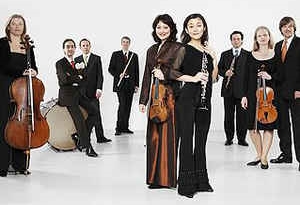 Photo: zVg
Photo: zVg
